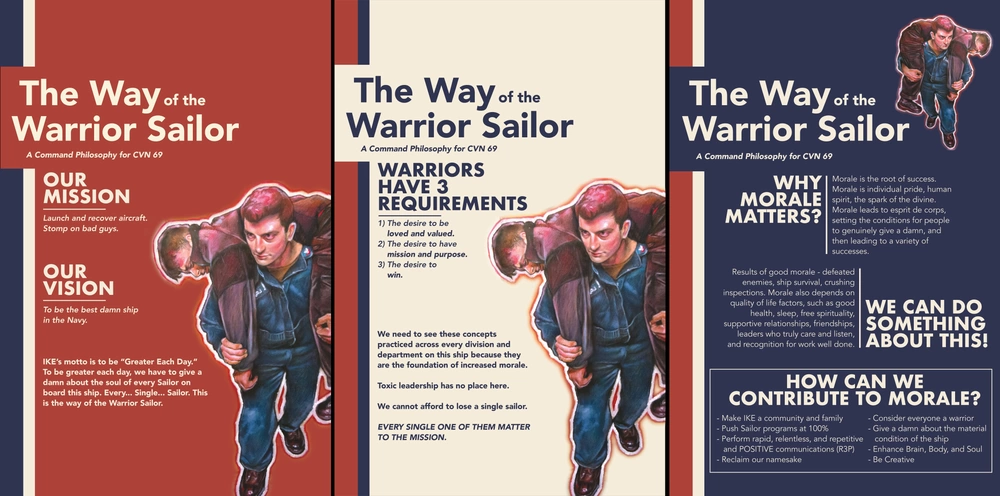Sometimes, great leadership appears effortless. The leader’s actions seem intuitive and simple, yet the impact is powerful. I was inspired by US Navy Captain Chris “Chowdah” Hill, who earned the nickname for his thick Boston accent. I stumbled upon him while listening to a podcast on conflicts in the Middle East.
Captain Hill commands the US Navy’s nuclear aircraft carrier, Dwight D. Eisenhower. The “IKE” recently completed a 9-month deployment to the Red Sea to protect international waters and shipping from Yemen’s Houthi terrorist organization. The IKE carrier strike group engaged in the most extensive naval operationssince World War II, firing hundreds of missiles against the enemy.
Captain Hill gained notoriety for making the IKE outstanding—improving morale and the crew’s operational effectiveness. The “cookie post” was one of his leadership activities. It went viral and even drew the enemy’s attention. He invited sailors to the ship’s bridge, let them sit in the captain’s chair, offered them a cookie, and then shared the moment on Instagram. Crew members’ parents started sending him messages asking for pictures of their children. An estimated 54,000 cookies were baked during the deployment.
Managers and leaders at all organizational levels can learn from Captain Hill. His approach to leadership is instinctive. His actions were low-tech, easy to implement, but very effective. “Chowdah” is passionate about authentically connecting with the team and creating a powerful sense of purpose and mission. These lessons are universal and apply to all high-performing organizations.
Creating Community
An aircraft carrier is a small city of nearly 6,000 people—3,200 sailors and an airwing of 2,500. Captain Hill articulated a leadership philosophy called “The Way of the Warrior Sailor.” Warriors have three requirements:
- A desire to be loved and valued.
- The desire to have a mission and purpose.
- The desire to win.
Captain Hill embraces leadership and sees his personal role as creating an environment where the entire crew feels “loved and valued.” Many videos show him roaming the ship and casually meeting with ordinary sailors. He invites small groups of 10-15 people to his cabin for informal chats and cookies. He recognizes the importance of making personal connections. Manager Tools (in one of my favorite Podcasts) describes how relationship power is the most enduring and effective.
The Way of the Warrior graphic evokes iconic World War II posters, showing a sailor using a rescue carry. This powerful image reinforces the sense of team interdependency. In battle, lives depend on your colleagues.
In business, lives are not on the line. But to be successful, we must work as a team. Agile embraces this core principle in its values and principles. “Build projects around motivated individuals. Give them the environment and support they need, and trust them to get the job done.”
These needs are fundamental human needs and are not exclusive to the military. They align to David McClelland’s Three Needs Theory:
- Need for Affiliation: The desire to establish close personal relationships.
- Need for Power: The desire to impact their environment and use their power to achieve the organization’s goals.
- Need for Achievement: The desire to excel and achieve.
Creating Purpose
Most vision and mission statements stink. They use fancy words that convey nothing. Mission and vision statements must be clear, inspirational, and aspirational.
The IKE’s mission statement is clear, “Launch and recover aircraft. Stomp out bad guys.” Simple. Clear. Evocative. Everyone on the ship understands why they are there. The vision is equally compelling, “To be the best damn ship in the Navy.”
There is a legendary story of President John F. Kennedy visiting NASA in 1962. The President asked a janitor about his role. The man responded, “I am helping put a man on the moon.” This vignette is often cited as an example of a mission-driven organization and demonstrates the importance of aligning people with the organization’s goals.
Dan Pink describes “purpose” as the cheapest way to improve performance. People are motivated when they feel they are making a difference. Their efforts contribute to a greater whole.
Documenting values and mission alone is not enough. They need to become embedded in the organization’s DNA. Leaders must constantly communicate and demonstrate their commitment to these guiding principles. The Rule of 7 is an old marketing maxim regarding the importance of being exposed to a message multiple times. Captain Hill broadcasted messages to the entire crew. Sailors emblazoned “Best Damn Ship” in giant capital letters in the hanger bay.
Love Your People
The IKE’s motto is “Greater every day.” Where achieving greatness means “giving a damn about the soul of every Sailor on board this ship.” Captain Hill unabashedly talks about “loving and valuing everybody.” He quickly notes that talking about “souls” and “love” are not commonly associated with the military.
The relationship between managers and employees is the most critical factor in organizational success. Gallup’s research underscores this: The relationship between an employee and their direct manager accounts for 70% of the variance in employee engagement. Organizations with high engagement are more profitable, have higher customer service scores, and experience lower turnover. On the IKE, the ship’s inspection scores rose as morale improved.
Captain Hill embraces the universality of basic human needs and motivations formed over hundreds of thousands of years. He rejects the notion that Millennials and Gen Z are different. He dismisses the stereotypes and honors his sailors, “These folks work hard every day in dangerous, inhospitable conditions, and yet they never give up the fight against evil. So much for those Gen Z stereotypes.” However, he does joke that Boomers have better music.
The pattern of one generation complaining about the next is well-documented and dates back to the ancient Greeks. Even Aristotle complained that the younger generation “thought they knew everything.” Boomers radically rejected the conformist values of their parents in the 1960s. Then, they became the “Me Generation” in the 1970s, who complained that Gen X did not share their values.
Great leaders build teams. They focus on commonality. They build esprit de corps. They motivate and inspire.
To view interviews with Captain Hill:
- USS Eisenhower commander Captain Chowdah Hill’s secrets to inspiring leadership
- FDD Morning Brief | feat. CAPT Chris “Chowdah” Hill (Dec. 2)
See related articles:
- The Evolving Arc of Management
- Projects are About People: 7 Ways to Put People First
- Simple Rules for High-Performing Agile Teams
© 2025, Alan Zucker; Project Management Essentials, LLC
To learn more about our training and consulting services or subscribe to our newsletter, visit our website: https://www.pmessentials.us/.
Image courtesy of: https://www.dvidshub.net/

